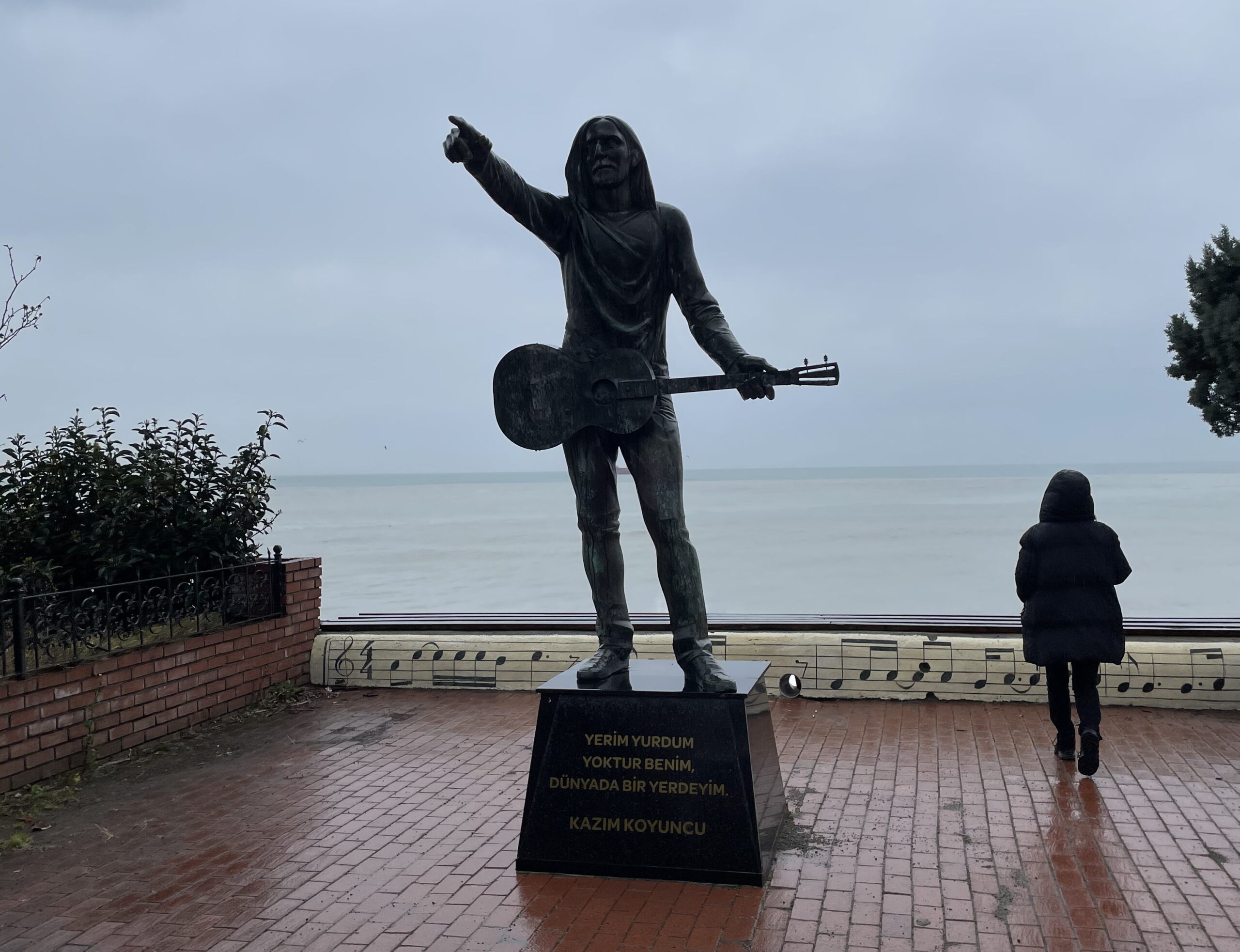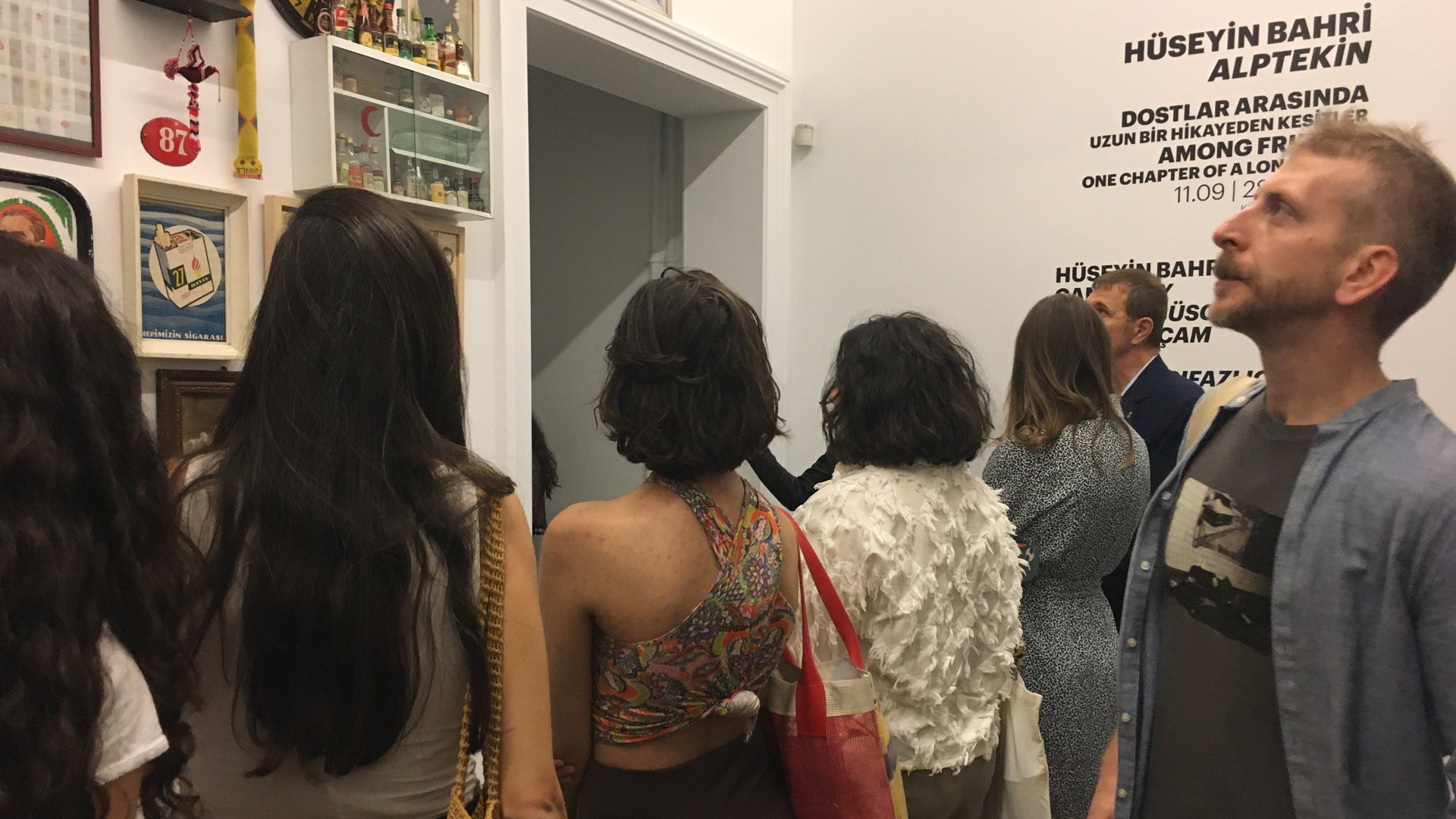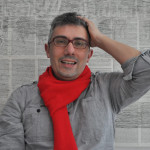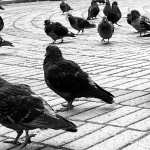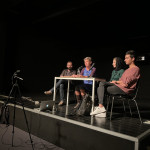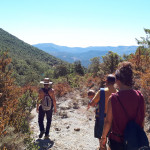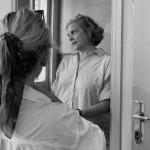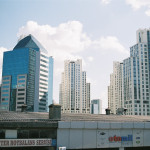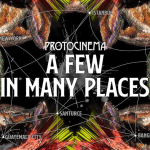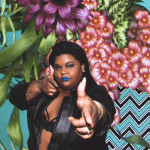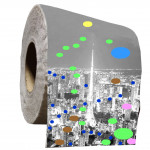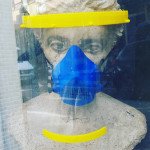Urban Voices
Marlene Kadgien
“I am a musician, then I am a bit of a Black Sea person, but above all I am a revolutionary. And I don’t hesitate to put forward what I really know to be true, at least if I am forced to do so.”
“Ben bir müzisyenim, ondan sonra biraz Karadenizliyim, ama hepsinin ötesinde ben bir devrimciyim. Ve gerçekten doğru bildiğim bir şeyi en azından çok zorlanırsam ortaya koymaktan çekinmem”
During my time in Turkey I visited the province of Artvin on the Black Sea coast in the northeast of the country for the first time. Whilst I had the opportunity to experience the cultural, natural as well as the political settings that are given in the eastern Black Sea Region.
One of the biggest music icons of Artvin was Kazım Koyuncu, a Musician, Songwriter, Actor and Activist. With his lyrics, poems and speeches he was a left-wing pioneer and therefore a role model for many young people in the region.
He was born in November of 1971 in Hopa, Artvin. In the 80’s he moved to Istanbul to pursue his musical career and released his first songs with the Band ‘Zuğaşi Berepe’ (Children of the Sea). In the year of 2001 Koyuncu released his first solo album: “Viya!”
In the following year after his first big success, he was asked to compose the soundtrack for the popular TV series “Gülbeyaz” and also tried his hand at acting for a small role in the series. His breakthrough came with the ‘Hey Gidi Karadeniz’ concert series.
In 2004 after he published his second and last soloalbum: “Hayde” he fell ill with lung cancer which could later be traced back to the Chernobl disaster. In 2005 he gave his last concert and succumbed to the consequences of his cancer on June 25, 2005.
Kazım Koyuncu became the first musician with Laz descent to gain mainstream success and therefore contributed significantly positive to the identity of the Laz people. With his songs realized in Lazca, Hemşince (Homshetsma/Hamshetsma) Turkish, Megrelian and Georgian language he toured in the whole country.
In his music he added both authentic and modern elements to his music with bass, electric guitar, drums, and computer-aided sounds, as well as Black Sea authentic instruments such as Tulum, Kemen, and Kaval. Therewith he created a synthesis of traditional Black Sea Music and Rock Music and his unique style of music.
Since I only learned about the importance of Kazım Koyuncu due to Eda, a close friend of mine. I asked her what role he played in her life as a young woman being born and raised in Hopa.
Calling him “Brother Kazım”, Koyuncu always took a familial part in the lives of Eda and friends from the eastern Black Sea Region.
For her Kazım was not only any songwriter but was a political and philosophical idol. She was listening to his speeches at concerts, and still lives after his ideologies.
Her thought patterns on certain topics such as individualism, humanity, war, injustice, love, being a world citizen in his sense of living and more were consolidated and clearly shaped by the song lyrics.
Symbolic to the importance of him in her life, after his death Eda and her surrounding used to console themselves with the following sentence:
“Kazım abi ölmedi, aramizda yasiyor” (“Brother Kazım haven’t died, he lives with us”) [...]
Read more...
Sabine Küper
The exhibition “Among Friends: One Chapter of a Long Story” showcases works by artist Hüseyin Bahri Alptekin (1957-2007) and 16 of his close friends. In her conceptual text, Curator Pelin Uran quotes French philosopher Jacques Derrida‘s reflection about the dilemma of friendship.
“There is a future, which is predictable, programmed, scheduled, foreseeable. But there is a future, l’avenir, which refers to someone who comes, whose arrival is totally unexpected. For me, that is the real future. That which is totally unpredictable. The Other who comes without my being able to anticipate their arrival.” ~ Jacques Derrida
During Alptekin‘s lifetime, his friends were closely involved in the artist’s constant search for innovation and new inputs. His passion for collecting items of daily use and his drift through Istanbul were usually done in company with others. “I am not a studio artist“, he would emphasize. His second nature was opposing common views and deconstructing the mainstream.
Alptekin was deeply influenced by Jacques Derrida, he had visited his lectures at the Sorbonne. Deconstructionism is rooted in what Derrida called Différance: meaning is not static but rather constantly changing, a constantly morphing competition between concepts. The continual inquiry keeps intellectually engaged in seeking alternative perspectives and comprehensions. There is no definitive conclusion; the process of inquiry is the ultimate goal.
The same intensity can be found in Alptekin life, as Pelin Uran points out: “ found his creativity and vital force in movement, in flights, in frontiers and in thresholds as something to cross, to go beyond. Otherness and displacement, the flow of immigration, not belonging, not feeling at home in anyplace, the desire to flee and the melancholia that accompanies it have been the major concerns both in his life and in his work, as well as threshold philosophical concepts like hospitality and hostility, creation and destruction, high and low”.
The exhibition evokes Derrida‘s conception of friendship, highlighting the fact that every friendship is structured from its inception by the possibility of one of the two friends passing away first, leaving the remaining friend to grieve. Alptekin’s unexpected passing in 2007 meant a huge loss to all those close to him. However, his spirit as an artist inspires his friends until now. “Among Friends: One Chapter of a Long Story” features some works of his wide friend circle.
“Among Friends: One Chapter of a Long Story” can be seen at Galerist in Istanbul, until 28.10.2023.
Participating Artists: Hüseyin Bahri Alptekin, Can Altay, Thomas Büsch, Tunç Ali Çam, Grip-in (Ali Cindoruk, Eray Makal, Erhan Muratoğlu), Ayhan Hacıfazlıoğlu, Minna Henriksson & Staffan Jofjell, Şirin İskit, Emre Koyuncuoğlu, Michael Morris, Serkan Özkaya, Camila Rocha, Vahit Tuna and Nalan Yırtmaç. [...]
Read more...
Maëla Sanmartín
Raphael Vella is an artist, curator and teacher based in Malta. He did a Bachelor’s in Education (1991) and a Master’s in Arts (1997) at the University of Malta and concluded a PhD in Fine Arts at the University of London in 2006. Since 2009, Vella has been curating exhibitions and creating diverse cultural initiatives such as the Valletta International Visual Arts festival (VIVA). From 2000, he has enjoyed several artist residencies around the world, and his artworks have been exhibited in many international contexts. Currently, he is also an Associate Professor at the University of Malta and has worked extensively to promote the work of emerging Maltese artists (1).
Raphael Vella participated in the Mahalla Festival – Murmuration– 2021 in Istanbul with the installation and the stop motion animation Antibody. His new work News from Nowhere was on display in Japan 2022 and will be on display in Malta at Valletta Contemporary this year, curated by Maren Richter.
INTERVIEW with Raphael Vella
By Maëla Sanmartín
Did you always want to be an artist?
I think so. When I was a kid, both of my parents were teachers, so there were lots of books at home. Neither of them was an artist or had any kind of inclination towards art, so it didn’t really come from them. But I remember the house was full of books and paper. And I would make lots of drawings on these, any piece of paper I found around the house. In the beginning they thought I was just scribbling. But then they realized it was more than that, because it was an obsession. They started sending me to lessons, and that’s how it started.
Would you say that art is political?
I think it’s important that art has to be political. In my case, I’ve always been interested in the relationship between art and politics. Also, the more I matured, the more I understood how important it is to think about the relationship between art and life. I never liked the idea that art is simply a case of letting your imagination run loose. Of course, I like creative ideas in art, and I tell my students it’s really important to be creative. But I’ve always thought as well that it’s important to ground that creativity in real life and social issues.
You’ve worked with diverse topics like migrations, gender, medicine, history… Which one would you say is the topic that touches you the most?
I’m interested very much in the relationship between medical, political and educational practices. In a sense, all those different disciplines try to improve our lives. And my question is: can we actually do anything to generate a change? And do artists need to be given this kind of extra responsibility? Are artists like teachers, or are they expected to be like doctors? If you go to a doctor because you’re sick, you expect to get better. Do you go to an artist for the same reason? This is a question I like to ask myself all the time, and it’s at the bottom of what makes me move forward as an artist. Thinking about the relationship between art and healing.
Raphael Vella. Medical School, 2012.
You have a quote on your website: “no matter how much we attempt to destroy or forget our past, it returns to haunt us”. What relationship do you have with the past? How does it influence your art?
All art or literature is a kind of reaction to what has already come before us. So you can’t really ignore the past or erase it. In my work, I have sometimes tried to use processes of erasure. For example, using pages from books and crossing them out. When doing this, the text is still there, it’s still visible. Even if it’s not as legible as it was before. And this is a way to show that no matter how much you try to forget your past, your past is still going to haunt you and it’s still going to be there, all the time.
What are your sources of inspiration?
Current events sometimes inspire me. But also the future, the unknown. And the fact that the future is a bit shaky, a bit scary, because you’re never sure what’s going to happen. Now, with so many issues related to climate change and so on, the future doesn’t look great for future generations. And that is something which I think about quite often. I also usually think about any situation in which we communicate with others, what I call dialogic situations. Situations which make me create some kind of dialogue with other people, or assemblies of people coming together to try in some way to improve their lives.
Raphael Vella. Antibody, Installation and Stop Motion Animation in Istanbul 2021
Do you believe in something like a revolution, with art involved?
The easy answer to that question is no. Nobody’s going to expect art to create some kind of political revolution that will change the world, in the same way that the French Revolution changed Europe, for example. So, the answer is no. But I do believe that art and other aspects of art, for example in educational settings (not only with children, but also with adults) can be part of a slower process. However, very often it’s so invisible. But just because you can’t see it, it doesn’t mean it’s not there.
Which one do you prefer: teaching or doing art?
That’s a difficult question. Well, I think in my heart I prefer art. You know, I’ve been teaching for over 30 years, and I think I’ve given students enough. Don’t get me wrong, I love teaching, but it’s something you must do in a way for a living. If I would have tried to survive only through my art, I would have probably died of hunger ages ago (he laughs).
What do you think is the power of teaching and the power of art?
The power of art is, I think, the power of empathy. Connecting with people you don’t even know. The power of teaching is the ability to connect with people you do know. And this is a beautiful process which grows over time.
Does art have a meaning for you?
Yes. I mean, for me that question is the same thing as if you were asking me “does life have a meaning for you“?
Raphael Vella. News from Nowhere, Stop Motion Animation 2022
Is your future predictable or unpredictable?
I don’t know if I’m going to be alive in three years, so I don’t plan it too much, you know? But to some extent, I’m kind of in control of my future. I tend to plan projects one or two years ahead. But not much longer than that, because then it becomes too far in the future. And then, in your daily life I get these moments of unpredictability. For example, getting invitations, being part of exhibitions or projects. So I never know, perhaps next week I will get an invitation to be part of a project, and it happens. So yeah, to some extent I can say my future is predictable. Luckily, it’s also unpredictable, because even when you’re doing your own art, you’re never a hundred percent sure what’s going to happen.
We did an interview with Aaron Bezzina on InEnArt, who is also an artist living in Malta. I wonder if you, artists in Malta, are in contact or create cooperation networks.
Aaron was my student, for like a year or so. And I know him from other things, because I curated two or three exhibitions in which he was involved. At that time, he was an emerging artist. Now he’s more established. But your question is perhaps more important than you can imagine, because here in Malta (despite our small size) there is not much collaboration, unfortunately. Around 18/19 years ago, I coordinated a group of contemporary artists. There were around 10 of us, but it lasted perhaps three years, not more. It was difficult to survive for longer. So it’s not easy to collaborate, but I don’t feel guilty about not having offered a hand.
What can you tell us about your latest work, News from Nowhere?
It’s called News from Nowhere because it was inspired by a novel written by the socialist William Morris in 1890. He really had this kind of utopian belief that art can change society, and he believed it could change society through work. If all work could become like a form of art, then you would enjoy going to work. He was very much inspired by Marx’s ideas, and he wrote this novel where the main character basically wakes up in the morning and finds himself in a completely unknown world in the future. And this world has been transformed into a kind of communist paradise where everyone loves going to work and he’s walking around the streets. But he totally doesn’t recognize the place or the people, because everyone seems happy.
So what I did in my animation is that I took the basic structure of the novel, but then turned it completely upside down. It’s only a five-minute animation (but it has about a thousand frames) where you get someone waking up, going out and finding a completely transformed world. But it’s a world on fire. The whole place is literally on fire, and there are explosions everywhere. Later, the man just returns home completely shocked. He looks at a plant, waters it and that’s the end of the animation. So, even if the world around us is changing (maybe for the worse) there is still hope and the possibility of dreaming of change.
Raphael Vella (n.d.). raphaelvella.com. Available at: http://raphaelvella.com/ [...]
Read more...
Marlene KadgienThomas Geiger studied Fine Arts in Karlsruhe and Interdisciplinary Art in Tallinn, Estonia and is now settled in Vienna as a performance, sculpture and language artist with a focus on public space.
He is currently in Istanbul for a 3-month stay as part of the International Residency Program of the Austrian Cultural Ministry accompanied by the Austrian Cultural Forum Istanbul and Diyalog.
Co-financed by the Goethe-Institut, he was invited to the “Arter” Museum, one of the most renowned art houses in Istanbul, to present his performance “The Pigeon“, adapted to Turkish public space.
However, under the current conditions, triggered by the terrible earthquake in southern Turkey, Kurdistan and northern Syria, the performance has been cancelled until further notice.
Geiger plans to realise the performance in another house or place in a respectful way towards the earthquake.
In his performance “Le Pigeon” (The Pigeon), first realised in Paris, Thomas Geiger shifts the perspective of the recipient and focuses on the omnipresent pigeon in public space. In doing so, he gives a voice to the expert for this space, as Geiger calls the pigeon, in order to draw attention to its living space, which is threatened by privatisation.
In the continuing version in Istanbul the pigeon is to remain the protagonist as a recurring character, sharply criticising and questioning the advancing privatisation, which is often only distinguished from private space by only fences or walls.
In this way, he places objects of everyday life and daily perception in a slightly shifted context and encourages the recipient to rethink the prevailing structures.
In his new project “Istanbul Simit Exchange”, Thomas Geiger plans to buy a vendor’s daily supply of simits and offer them to pedestrians for free. In return, he invites them to draw their own simit on a sheet of paper as a value compensation. As is well known, the steadily decreasing purchasing power of the Turkish lira can be illustrated by the price of simits and underlines the ever-shrinking, affluent middle class and ever-increasing poverty in Turkey. The basic idea of the project is to take up and critically question the issue of value representation and the payment for creative work. So you don’t pay for your simit with money, but with a small, creative, self-produced piece of work. These creative imitations of the simits will then be sold in Vienna as components of his project “I want to become a millionaire”, which has been running since 2010.
The performance was canceled because of the earthquake that took place Feb 6 in Turkey and Syria. Instead the artist will prepare a video of the performance which will be screened later on. Watch out for further notification. [...]
Read more...
Maëla Sanmartín
Since the Taliban’s took control of Afghanistan in 2021, women’s rights have been in grave danger. In the film Life in the Taliban’s Afghanistan, reporter Isobel Yeung deepens into the current state of women’s rights in the country and shows how their lives are under the Taliban’s rules. In Afghanistan, women are deprived of going to work, studying and even going outside home. Streets, parks, schools and even courthouses are now dominated by men, as the Taliban don’t believe in gender parity and equality before the law. Under this situation, there are lots of cases of sexual, physical and psychological abuse that are remaining hidden in the country, benefiting the power of the man over the voice of the women. Even if the Taliban assure that women’s rights are being defended in the country, they have established a discriminatory government in which women are being removed from the public life, marginalized and mistreated. In addition, Afghanistan is facing a humanitarian crisis in which medical care is scarce and some people don’t even have access to it. This represents a critical situation in which many children have problems for surviving and, if they do, they will have a black future ahead. Even more if you’re born as a girl.
The movie Life in the Taliban’s Afghanistan was screened Oct 8 at Salt Galata in the frame of the Kite Runner project taking place in Istanbul between July and December 2022.
The Kite Runner Project
The Kite Runner project is an initiative of the Istanbul based association Diyalog which started in August 2022, in cooperation with the International Media Support (IMS) based in Denmark.
Inspired by the novel Kite Runner by Afghan-American author Khaled Hosseini this project aims to provide workshop opportunities, organise social events and network building activities for Afghans with journalistic and media background living in Turkey. Some of the gatherings are just online meetings for those who want to attend the activities from Afghanistan or any other part of the globe.
Among the activities we can find language courses, film screenings, legal advice and media workshops, available for Afghans with and without journalistic experience. There are also specific working groups for female journalists. The condition for the participants to attend the events is to have interest and enthusiasm about video, filmmaking and journalism, and to show passion for social justice, equity and human rights. The objective of the Kite Runner project is to encourage the participants to use their skills for creating movies about their environment, their own journey, community life or conflict situations. Everything to serve as social gathering, networking booster and a platform to professionalizing media skills while promoting intercultural understanding between borders.
Afghanistan has been qualified as “the worst place to be a woman”. With the work of the Kite Runner project and the involvement of the public activities organised in Istanbul, we will get to spread and raise awareness about the significant problematic in Afghanistan and denounce the hard violation of human rights in the country. [...]
Read more...
Maëla SanmartínPeople from several regions of Spain and different countries in the world met last weekend in Lakabe (Navarra) on occasion of the 2022 Spain Ecovillage Gathering, organised by the Iberian Ecovillage Network (RIE). Workshops, concerts, screenings and project presentations took place from Friday to Sunday to learn about alternative ways of living, find people with similar aspirations, raise ecological awareness and build national and international cooperation networks.
Lakabe, Spain
Lakabe is a little village in the valley of Arce-Artzibar, Navarra (Spain). It became uninhabited in the 60’s and was occupied in 1980 by a group of young people from the conscientious objection movement who dreamed of building an alternative and transformative community space, adapting to the rhythms of nature. Today, this project continues with this same essence: to enable and experience utopia. (1)
Lakabe is part of the Iberian Ecovillage Network (RIE), who each year organises gatherings in the ecovillages that are part of this national network. Besides, Lakabe is part of other networks as CEPAIN, Bizilur, Amnesty International, Alejab, EHKO and others. They also collaborate with GEN-Europe, the European Ecovillage Network formed of international communities, ecovillages and national ecovillage networks that work together to create a regenerative world. (2)
Lakabe’s economy is based on the bread they make and sell outside their community, in their own animals and the food they groove in their gardens. All the economy of the community is shared: when a new member joins (after two years of trial), he or she must give all his possessions and properties, which automatically become part of the community. No private properties exist in Lakabe. Their way of organisation is through horizontal decision making, they don’t have Internet connection and they keep a responsible lifestyle using dry toilets and short showers due to water scarcity.
THE ENCOUNTER
Botanical alchemy workshop
Lakabe’s Ecovillage Gathering 2022 started on Friday morning and ended on Sunday afternoon. During the two and a half days, people from all over Spain and even from other countries (Italy, Argentina, Colombia…) met to learn about alternative ways of living, ecological practices and horizontal ways of social organisation. The encounter intends to create links between people who want to join an eco community or that have the idea to create a new one, and for people who already have a community and want to improve their practices and gain experience. Besides, this encounter is also open for people who just have curiosity about ways of living out of the system, taking care of nature and escaping from the instantaneity and speed of today’s world.
2022 Ecovillage Gathering program in Lakabe
The weekend was organised in different workshops, talks and screenings in which people had the opportunity to learn, listen and share together. Some of the workshops that were organised for the encounter were about collaborative economy, non-violent communication, sociocracy, free currency, botanical alchemy and holistic farming, basketry, food preserves and wild lemonade, world dancing and tribal contact. All of them were conducted by experienced people in the field and had a length of approximately two hours. During the first part of the workshop, the expert used to share his or her knowledge. At the end, people started asking questions and the workshop became a conversation between the participants and the expert, as well as a forum to share ways of thinking and collective concerns.
Improvised musical moment in Lakabe
The spare moments were especially good to meet, relax and make friends. People spended the free time sharing opinions and experiences, talking about themselves and their dreams. Some beautiful moments emerged during the encounter, such as spontaneous dancing or improvised musical sessions. The mealtimes were especially good, as people joined together to share some exceptional ecological cooking. The nights were full of joy, as people gathered in the main place to watch the concerts that were organised for the encounter. The Katanga Dub concert on Saturday night was one of the most funny and memorable moments of the weekend.
In sum, 2022 Ecovillage Gathering in Lakabe was a beautiful and emotional experience in which we had the opportunity to disconnect from technologies, escape from today’s society speed and have intercultural exchanges. Every person in the encounter had different ways of thinking, but we all had the same motivation: move and walk towards utopia, a new society in which people can live in harmony with the ideals of respect, tolerance, multiculturality, ecology and responsible progress.
Lakabe, tierra de bosques. Lakabe.org. Available at: https://www.lakabe.org/
Gen Europe. gen-europe.org. Available at: https://gen-europe.org/ [...]
Read more...
Aliette Dumont Saint Priest
Barbara Eichhorn is a German born visual artist living in Austria. At the moment she is artist in residence for three month in Istanbul supported by the Federal Ministry for Arts, Culture, the Civil Service and Sport Austria.
Every year, the Federal Ministry for Arts, Culture, the Civil Service and Sport sends around 50 artists to the thirteen foreign studios of the republic, for a period of three to six months. Since the 1970s, about 950 artists have been invited to work in these temporary studios, in order to discover and expand the artistic situation on site and their own work in a new environment.
In Istanbul the Turkish association diyalog in cooperation with the Austrian Cultural Forum Istanbul are supervising the program.
In Vienna Barbara has her studio in the Sonnwendviertel district, a new neighborhood of the Austrian capital behind a newly built train station. This modern venue is a perfect playground for artistic expression, an opportunity Barbara seized with fellow artist Daniel Aschwenden for the Thishousebylines project in 2021. They were dealing with the “relationship between movement and drawing as contemporary, (analog) art media in digital times”.
This matter is really central to Barbara Eichhorn’s work : lines, lines, and lines, the movement of the pencil on the paper going from one point to another until something comes out of it. The artwork she is producing is creating matter, shapes and structures from a succession of pencil lines. It is as much from the tracing of lines as from the spaces that separate these lines that the forms appear.
Art residencies are always an occasion to see how an artist’s work is modified outside of his usual environment, an opportunity to explore other cultural contexts, and to establish intercultural communication.
Being away is something that really resonates with Barbara Eichhorn’s work, as going in different directions is part of her way of working. She is wandering around Istanbul to have a look at the shapes, the lines and the contours, focusing on the movement that is leading her arm as she is traducing into another language the visual image that the urban landscape is sending her.
The images are superimposed on each other, without hierarchy, creating a relational aesthetic that translates the urban landscape into forms and sensations.
We are walking with Barbara Eichhorn through the Kadiköy district of Istanbul and visitng art spaces like Apartment 52 and arthere while she is preparing her contribution for the Mahalla Festival in Istanbul. This years festival will take place between August 23 and September 14 mostly in the Kadiköy destrict of Istanbul under the title Windmill Mountain dedicated to the Murmuration birds. Murmurations are huge groups of starlings that twist, turn, swoop and swirl across the sky in beautiful shape-shifting clouds.
For the festival Barbara is preparing an interactive drawing performance with the title My Hand is Your Hand is My Hand.
Hands lie on top of hands and together they follow lines drawn on paper.
Take in, perceive, take with you, connect, pass on, and hand over.
For the Mahalla festival Barbara Eichhorn will do an interactive performance in Kadiköy, Istanbul. She will draw collectively with passer-by and friends who are around on small papers. The performance invites you to linger, to ask questions, to reflect and to participate. It invites residents, neighbors and passers-by as well as interested art audiences. That’s the way of Murmuration. [...]
Read more...
Aliette Dumont Saint Priest
The Otonom Art Events, held between the 1st and the 6th of June 2021, describe themselves as « accessible, innovative, free, contemporary » art events.
As the Contemporary Art Fair of Istanbul – one of the biggest international fairs of the country – was taking place at the same time a few kilometers away, the OAE was making a rather different proposition : garage, art, metal, rust… A succession of art studios were open to the public in the 6. Sokak and 9. Sokak of the district of Maslak, Sarıyer.
Atatürk Oto Sanayi : skyscrapers, garages and art studios
The landscape is rather surprising as you reach the neighborhood. The Otonom Art Events are established in the middle of the Atatürk Oto Sanayi, an industrial complex dating back from the 70’s. As the years passed by, the district of Maslak in which the garage is located transformed itself into one of the most important business districts of Istanbul, seeing dozens of skyscrapers emerging from the ground. Business towers, car garages, and art studios : the composition is particular but manages to create a singular harmony that « brings the art, the artist and the audience together ».
Indeed, we are far from an exclusive and unwelcoming art gallery. The doors of the studios are warmly open and sometimes you don’t really know if you are entering someone’s private place or an artwork studio. There is actually not much difference as these two streets, 6. Sokak and 9. Sokak, are the margin spots where different artists settled in the last years. They enjoyed these suburban areas as creative spaces to produce their work, thanks to the space and ambiance it could provide. One of the participants of the Otonom Art Events said « I actually came here because it’s the only place in Istanbul where you can put music really loud without being bothered ». Therefore, the Atatürk Oto Sanayi is an alternative place giving birth to an art in link with its surroundings.
Metal and rust
The 6th and 9th Streets are hosting some Turkish artists but not only, as they also accompany German-Turkish collectives like Metallwerstatt Tacheles and Komünart. That’s the case for example of the artist Hüseyin Arda, based both in Berlin and Istanbul, and to whom we owe the big metal rhinoceros installation. Cutting metal pieces and welding them together, there is no much doubt why he has set himself in this venue. More or less all the artworks shown during the Otonom Art Events are exploiting metal as their main component, creating a substance harmony with the rest of the district, the motos resting in the garages and the noise of the workers fixing cars a few streets away.
This edition of the Otonom Art Events is now over but do not hesitate to have a closer look at their digital content as they regularly organize events. [...]
Read more...
Aliette Dumont Saint Priest
A Few In Many Places is an exhibition organized by ProtoCinema and held since the 24th of May on the first floor of Kıraathane ; an exhibition whose intention resonates with the purpose of the İstanbul Edebiyat Evi.
Kıraathane is an archaic word composed of qiraat which in Arabic means “reading” and hane which means “place”, “house”, “space”. This word is used in Turkey in the sense of coffee house, where newspapers and magazines could be read while drinking tea or coffee during the times of the Ottoman Empire. It’s also the name of the İstanbul Edebiyat Evi – İstanbul Litterature House – located in Beyoğlu, whose doors are open since October 2018. This venue works as a proper house: a get-together place for artists, writers, and people using their freedom of expression at a time when the latter is challenged ; a place to discuss literature, art and creativity, exchange ideas and promote creation.
a multidimensional exhibition
A Few In Many Places is a « multi-city group exhibition which addresses on-going collapses and cycles of violence, through various forms of collectivity » as can be read on the ProtoZine, the zine that accompanies the exhibition. In other words, ProtoCinema is engaging a simultaneous discussion in 6 different cities : Seoul, Bangkok, Istanbul, New York, Santurce and Guatemala City.
Far from presenting a globalized and asepticized art, all these interventions are careful to offer an interconnected art that’s still acknowledging its regional grip, with local artists for each one of the cities. On the curating aspect, a special attention is given to the use of « a sustainable exhibition-making model of reducing exploitation (of natural resources, labor and knowledge) and consumption (no shipping or flying) ». A Few In Many Places is a multi-level reflexion occuring in 3 different continents and 2 different universes, in both physical and digital realms.
repetition & perception
A few in many places can be understood as a willingness to return to the essential, to the ‘few’, to what is left when one got rid of the superfluous ; a persistent movement towards the atom, the tiniest component of what composes all of us, every substance, all over the world no matter where you find yourself.
It is to such an extent that can be understood the work of Zeynep Kayan, one of the artists whose work is part of the Istanbul exhibition. She uses video and her body as tools to show endless repetitions of small physical movements, « recalling somatic knowledge which our bodies carry and transmit for generations ». This inherited, unconscious, sometimes violent physical knowledge emerges from the repetitions of movements, as the artist is trying to disarm the violence through repetitive cycles.
One of her videos, titled An attempt to read from Thomas Bernhard (2021), represents the artist reciting a sentence from Bernhard’s Walking but as she recites she always interrupts herself before the end, and constantly goes back to the beginning of the sentence ; while in the meantime she carries water from one receptacle placed in front of her to another, and do it all over again.
The repeated sentence says : ‘‘We have to continue what we aimed to start, while we are conscious that nothing is ever certain and nothing ever has integrity. If we keep giving up before we start, we would not get rid of disappointment and we would get lost in the end.’’
In the other room of the exhibition is the installation of ARK, an collaborative work by Kathryn Hamilton and Deniz Tortum. The 4 walls-room is plunged in darkness, there is just a tiny hole in the black paper that covers the only window of the space, allowing a single ray of light to get in. The installation is working as a camera obscura, projecting on the wall in front of the spectator the landscape of the streets outside. As you accustom yourself to darkness, you can discern the bridge of Haliç, the Bosphorus.
This makes us enter into a reproduced world, a visual construction of reality ; entering into a discussion on perceptual knowledge. Hamilton and Tortum evoke the year 1970, when an object was scanned for the first time in an American laboratory, « transferred from the physical world into the digital one ».
In an epoch when virtual reality is getting more and more common, when computing technologies are trying to create a reality more real than reality itself, we can think of these simulations as a way to slip away from the outside world when this latter is collapsing. Some organic elements are introduced into the installation, such as an orange tree, to highlight how reality and time still have a grip on real and material objects in the “real simulation”.
The responsive aspect of the project led by ProtoCinema is central in the exhibition : the venue perfectly resonates with the artworks, the curating is in full coherence with the intention of the exhibition… All these factors make the visiting of the exhibition extremly fluid and the insertion into the dimensions created by the artists even more accessible.
A Few in Many Places, Istanbul edition, curated by Mari Spirito and Alper Turan, is going on until the 21st of June in Kıraathane İstanbul Edebiyat Evi, Yemenici Abdüllatif Sk., 1. Beyoğlu. [...]
Read more...
Renata ProcopioTo good observers one thing is a fact: the past isn’t disconnected from the present, and at the same time will never be disconnected from the future.
We live in cycles. Sometimes these cycles are more intense, sometimes slower. Slow cycles make us believe that history has crystallised.
And often this is the impression I get regarding art in Brazil. Especially art as a manifest.
Just as in the past, rupture movements keep happening in some societies. The ruptures are many, and lots of them arise through art.
In Brazil the activist movement that shook the environment of popular music and Brazilian culture started between 1967 and 1968, happening under the name of Tropicalism and fitting into the post-war context, the development of the cultural industry and the introduction and consolidation of the media (radio and television). One of the most influential singers of the movement was Caetano Veloso with the song Alegria, Alegria.
As Caetano later explained, the song is a report, in the first person, of a young man walking through the city. During a time of stagnation and lack of freedom, the song proposed movement and resistance. Caetano spoke of walking “against the wind”, that is, against the direction in which he was being pushed.
No scarf, no document
Nothing in my pocket or in my hands
I want to keep on living, love
I’m going
Why not, why not
Currently, the activist movement gained new actors,fighting against racism and privilege mainly represented through the favelas. Some examples are:
Criolo – Boca de Lobo (Manhole)
The manhole, also known as a hollowed out curb, is inserted in intervals of the curb. It is a piece with holes that allows water to drain into the drainage network. Its application is absolutely essential to prevent flooding. But that will not depend only on its application, and the song talks about how much durtness we have “under the ground”.
Emicida – Boa Esperança (Good Hope) – He also got a documentary on Netflix
Emicida’s documentary is divided into three acts: Planting, Watering and Harvesting. To rewrite history, the rapper shows the need to reconnect with the land, so that it is possible to rescue his roots. In the current times, this movement is necessary for society and politics, and also for Brazilian hip-hop.
Djonga – Nós (We)
About compliance, struggle against elites and inequalities, how this has made them aggressive and unfeeling after so many years dealing with compliance.
The country – nowadays under the command of ‘Bolsonaro’s politics of hate, is caracterized as an homophobic government, once again dictatorial and fascist – still trying to follow the activist movement. The artists of the vanguard strengthen the current movement, which also gave voice to an activist festival (Ninja Festival), that surprisingly ended up with an unexpected ending: a kiss on the mouth between the tropicalist activist Caetano Veloso and the rapper Criolo.
Between unexpected actions without great gains for the population, one thing is a fact; in the Brazil of today as in many other countries represented by debilitated movements, if we try to see movements of ruptures, we can not find. They are mere appearances.
And what is worse, the more we try to rescue history, the more we kill it.
It would be more relevant to join ourselves together as humanity, in an attempt to save us from the history of an holocaust determined by a dozen of countries, to the misery of all the others.
The proposal then is that we can assume a new kind of artistic attitude, rescuing through voluntary work the Histories of all the countries that have been crushed by the crises: let us start with the musician Chico César and his song Mama Africa.
(The music was inspired by the African continent as a mother, from where so many children left/were taken for the Americas, Europe, the Caribbean, etc. Thinking of the African diaspora and how many times this movement turned its back on its mother, exploited until today by the colonizers, and to whom no retribution was given).
[...]
Read more...
Isidora2020: A RESTROOM CULTURALITY
2020 © Isidora Fićović and Daichi Misawa
Installed in New Belgrade, April 2020
A restroom for visitors to reflect upon a cultural boundlessness, or culturality, of restrooms in the
past, present and future, which comprises Gestural Rhythm of Dot recording a time dimension
of a process of movements in painting, and a musical sound of circulator that may reflect the
sound of present culturality in a place of installment. Material: toilet paper, painting or drawing materials (water color), environmental sound, real-time computer processing.
When technological impact on society takes its role, might be a time for artists to play their role.
Art, to us, does not seem to be something that only tolerates a specific ‘beauty.’ Things that are
‘ugly’ might be actually where humanity is. To be specific, restrooms such as Japanese one—whoa,
it’s a space of traditional hospitality, having within touch sensors for flash, toilet seat heats,
incredible softness of toilet paper, even a sound of nature—are considered here to be a site for
carrying out another artistic investigation.
Concept of the artwork generally relates to an idea of presenting a design of restroom as a
demonstration of restroom culturality. Based on said concept, the artwork comprises: 1) ‘Gestural
Rhythm of Dot’ recording a time dimension of a process of movements in painting, of yellow
color symbolizing suns’ movement and of blue color rivers’; and 2) a musical sound of circulator
that is synthesized with environmental sound reflecting the sound of present culturality in the
place of installation. As a result, the artwork presents another view on restroom design, and also
we hope it gives us a chance to reflect upon or test the notion, movement and music concerning
restroom in the past, present and future, a moment of relief contemplating the boundlessness of
the resting place.
2020 © Isidora Fićović and Daichi Misawa [...]
Read more...
Sabine Küper
#anarchyzen is the label of a Turkish Street-artist. During the pandemic days the emptiness of the streets unveils a rich fundus of artworks from Graffiti to complex paintings. They provide a dialogue with the city and its ongoing topics. #anarchyzen is partly using objects in the environment and transforms them creatively.
Söyleşi #anarchyzen Talk
Cümlere sıkışıp kalmayan bir oluşun yolcusu olarak sanat insanları değiştirici etkileyici bir güce sahip ve insanları birleştiren bi yanı var tıpkı birbirimize çıkan sokaklar gibi…
Art is a passenger not limited to words; it has an impressive power that changes people and unites people; just like the streets, which unite us, because we are all walking on their path …
Yeldeğirmeni ve istanbulun çeşitli yerlerinde sokak işlerim oldu… gezgin bir yaşantım olduğu için gittiğim bir çok yere bıraktığım izler oluyor…
I did street works in Yeldeğirmeni and various parts of Istanbul … there are traces that I left in many places I went, because I am traveling and strolling constantly…
Bazen fikir mekanı seçiyor bazen mekan fikri tetikliyor… vapurlar trenler sokak duvarları reklam panoları logar kapakları doğal gaz ve elektrik kutuları baz istasyonları kameralar uyarı afişleri merdivenler okulların cevresi çöp kutuları trafik levhaları ve lambaları vb. her şey ve heryer sanat ile dönüştürmek adına özgür ifade alanım olabiliyor…
Sometimes the idea chooses the space, sometimes the space triggers the idea … ferries, trains, street walls, billboards, logar covers, natural gas and electrical boxes, base stations, cameras, warning banners, stairs, garbage boxes close to schools, traffic signs and lamps etc. Any place can be an area of free expression wit artistic tools… [...]
Read more...
Julie PetersOvercome the Void of a Plague – The Art of 3D Production
In times of material shortage for public goods, artists are often the ones who make the difference, using their creativity, their materials and their solidarity.
arthere is an art space in Istanbul, Kadiköy, run by artists who have formed a strong art community. The art centre gathers artists from the Middle East, Turkey and around the world with a management team from Syria, France, and Turkey.
Initially founded by and for Syrian artists with difficulties accessing workspace after leaving their country to settle in Istanbul, arthere is a space for artistic creation, away from war and political rivalries. Hosting all sorts of events such as film screenings, installations, performances, workshops and exhibitions, arthere always looks for news ways of promoting creativity and expression, while serving a good cause.
That is how Omar Berakdar, initiator and member of arthere, decided to get the machines working. It’s been one week now that the “printing farm” (that’s how he calls the five 3D printers that arthere owns) is working without respite to produce two types of protective equipment against Coronavirus:
The first one, a normal triangular plastic mask where a replaceable tissue or filter fit in. Fixed with rubber bands, it is useful for daily situations and easy to clean with an alcoholic disinfectant spray. This mask can be used for medical purposes and successfully replaces the normal ones which should be thrown away every 6 to 8 hours.
The second one is a plastic structure supporting a shield for people working in close contact with infected people: in hospitals, supermarkets etc. Those are the “easy ones” that arthere produces the most. They prepare 10 to 20 of them and send them all together to hospitals. They are already in use at hospitals in Bursa and in Gaziantep.
The initiative was set up by a community of 3D printer owners (3BoyutluDestek) that drawn more and more attention lately due to the general shortage in available masks for medical staff. The shield’s designs are available online, practical and easy to assemble.
When there is need, arthere sends the masks to anybody who asks. But that’s not going to last long… The material needed for the 3D printers are rolls of plastic string. Raw material goes into a tube, gets melted and transformed into a plastic shape. But for the moment, Omar and his team only have a filament called PLA, which is inconvenient because it melts or deforms when heated up to 60°C, common practice in hospitals for disinfecting and cleaning purposes. The material that would be needed is PETG.
Since the outbreak of the virus, arthere, as many other places, had to cancel the totality of their program. Being a space for solidarity, for mutual support within the community, making masks was seen as a responsibility. It isn’t only about the masks; it is the position of an art space, an active group of people who want to respond to the crisis.
It is possible to support arthere’s initiative by contributing to the required material: PETG filament.
It can be sent directly to the art space at the following address: Rasimpasa Mh, Beydagi Sk, 3A, Kadiköy, Istanbul.
Or, if more information is needed: Tel. +905380867691 / info@arthereistanbul.com. [...]
Read more...

